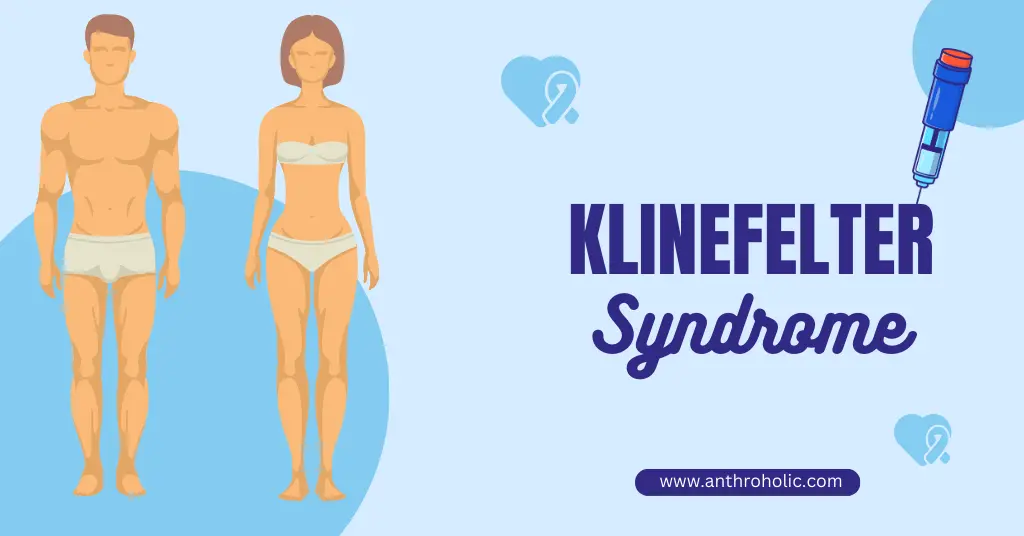AI Answer Evaluation Platform Live Now. Try Free Answer Evaluation Now
Klinefelter Syndrome
Klinefelter Syndrome, named after the American endocrinologist Harry F. Klinefelter, is a genetic condition that affects approximately one in 500 to one in 1,000 males worldwide (Bojesen et al., 2003). This condition is distinguished by the presence of an extra X chromosome, resulting in the typical male XY chromosome arrangement being replaced with XXY, or in rare cases, even more additional X chromosomes (Visootsak & Graham, 2009). Klinefelter syndrome’s impacts on a person’s health and development can be extensive, ranging from physical changes to cognitive and social challenges. This article provides an in-depth exploration of Klinefelter Syndrome, detailing its causes, symptoms, diagnosis, treatments, and the living experiences of those affected.

Genetics Behind Klinefelter Syndrome
The root cause of Klinefelter syndrome is a nondisjunction event that occurs either during meiosis I or meiosis II in the parental gametes. A nondisjunction event refers to a failure in the separation of homologous chromosomes or sister chromatids, causing an unequal distribution of chromosomes (NIH, 2020).
Table 1: Chromosome Distribution in Klinefelter Syndrome
| Parental Gametes | Child’s Chromosome Configuration | Resulting Syndrome |
|---|---|---|
| XX (Mother) + XY (Father) | XXY | Klinefelter Syndrome |
| XY (Mother, rare events) + X (Father) | XXY | Klinefelter Syndrome |
Symptoms and Complications
Klinefelter syndrome is associated with a range of symptoms, varying in severity and onset time. Physical symptoms may manifest subtly during childhood and become more apparent during puberty, while cognitive and behavioral symptoms may be noticed earlier.
1. Physical Symptoms
Common physical signs include tall stature, less muscle, broader hips, longer legs, smaller testes, gynecomastia, and sparse body hair (Gies et al., 2016). Some affected individuals might face complications like osteoporosis, venous disease, autoimmune disorders, breast cancer, and infertility.
2. Cognitive and Behavioral Symptoms
Cognitive and behavioral symptoms include learning disabilities, delayed speech and language development, issues with executive functioning, and social difficulties (Samango-Sprouse et al., 2015). Individuals may also experience anxiety, depression, and attention problems.
Diagnosis and Treatment
1. Diagnosis
Diagnosis typically involves karyotyping to determine the chromosomal configuration. Prenatal screening methods like amniocentesis and chorionic villus sampling can also detect Klinefelter syndrome before birth (Bardsley et al., 2013).
2. Treatment
While there is no cure for Klinefelter syndrome, treatments aim to mitigate symptoms and improve the quality of life. Treatment may include testosterone replacement therapy, physical therapy, occupational therapy, speech and language therapy, and psychological support. Assisted reproductive technologies may also be considered for individuals desiring to have children (Denschlag et al., 2004).
Living with Klinefelter Syndrome
Despite the challenges associated with Klinefelter syndrome, with appropriate support, individuals can lead fulfilling lives. Education and vocational guidance, along with emotional support from therapists, families, and support groups, can significantly help affected individuals navigate their journey.
Latest Research
A stem cell study carried out by the King Abdullah University of Science and Technology, King Abdulaziz University, Jeddah, and King Abdulaziz University Hospital, Jeddah, is the most recent study I could find on Klinefelter Syndrome. This study is unique in that it compared stem cells derived from a cohort of Saudi Klinefelter patients with a group of North American and European descent. Given that Middle Eastern and North African populations are largely underrepresented in such studies, this research contributes significantly to a broader understanding of Klinefelter Syndrome across different ethnicities and geographical areas.
The study employed a technique using “patient-derived induced pluripotent stem cells” (iPSCs), which are derived from skin, blood, hair, or urine-derived cell samples. These iPSCs can be reverted back to the embryonic state, allowing researchers to model the onset and progression of diseases “in a dish.” The findings of this study showed that Klinefelter syndrome is specifically characterized by dysregulation of a subset of X chromosome genes, independent of geographic origin, ethnicity, or genetic make-up. This research will likely serve as a platform for further exploration into chromosomal diseases and could have implications for personalized medicine applications. In particular, it could be used to model neurodevelopment and anatomical changes that are often observed in Klinefelter Syndrome, even creating “mini-brains” from patient-derived cells.
In addition to the stem cell study, a review article provides a comprehensive overview of the current understanding of Klinefelter syndrome. Klinefelter syndrome, characterized by the presence of an extra X chromosome, is the most prevalent chromosomal sexual anomaly. It results in various symptoms, including high stature, small penis, gynecomastia, feminine body proportions and hair, visceral obesity, and testicular failure. The syndrome can also lead to osteoporosis, obesity, diabetes, musculoskeletal disorders, cardiovascular diseases, autoimmune disorders, neurocognitive disabilities, and infertility. Despite testicular atrophy, reproductive treatments show promising results, with rates of 40-60% of spermatozoa recovery, 60% of clinical pregnancy, and 50% of newborns..
Unfortunately, I was not able to find a direct answer to your question about the role of iPSCs in fertility treatment for Klinefelter Syndrome patients. It might be worthwhile to note that the use of iPSCs in fertility treatment is still a very new and experimental field, and research in this area is ongoing. This is a rapidly advancing field of study, and I would recommend keeping an eye on the latest research for more updates.
Conclusion
Klinefelter syndrome, a genetic condition resulting from an extra X chromosome in males, encompasses a spectrum of physical, cognitive, and behavioral symptoms. Though challenges persist, with proper medical care, therapeutic interventions, and supportive environments, individuals can lead successful lives. As we advance in genetic research and therapies, we hope to see even better treatment strategies and improved outcomes for those living with Klinefelter syndrome.
References
- Bardsley, M. Z., Falkner, B., Kowal, K., & Ross, J. L. (2013). Insulin resistance and metabolic syndrome in prepubertal boys with Klinefelter syndrome. Acta Paediatrica, 102(6), 635–640. https://pubmed.ncbi.nlm.nih.gov/21251059/
- Bojesen, A., Juul, S., & Gravholt, C. H. (2003). Prenatal and postnatal prevalence of Klinefelter syndrome: a national registry study. The Journal of clinical endocrinology and metabolism, 88(2), 622–626. https://doi.org/10.1210/jc.2002-021491
- Denschlag, D., Tempfer, C., Kunze, M., Wolff, G., & Keck, C. (2004). Assisted reproductive techniques in patients with Klinefelter syndrome: a critical review. Fertility and sterility, 82(4), 775–779. https://doi.org/10.1016/j.fertnstert.2004.03.061
- Gies, I., De Schepper, J., Van Saen, D., Anckaert, E., & Goossens, E. (2016). Early development of boys with Klinefelter syndrome. Human Reproduction, 31(5), 1153–1162. https://doi.org/10.1093/humrep/dew038
- National Institute of Health. (2020). Genetic Home Reference: Klinefelter Syndrome. https://ghr.nlm.nih.gov/condition/klinefelter-syndrome
- Samango-Sprouse, C., Stapleton, E. J., Aliabadi, F., Graw, R., Vickers, R., Haskell, K., & Sadeghin, T. (2015). Identification of infants at risk for autism spectrum disorder and developmental language delay prior to 12 months. Autism, 19(3), 327–337. https://doi.org/10.1177/1362361314521329
- Visootsak, J., & Graham Jr, J. M. (2009). Klinefelter syndrome and other sex chromosomal aneuploidies. Orphanet journal of rare diseases, 1(1), 1-5. https://doi.org/10.1186/1750-1172-1-42
- “First-of-its-kind Stem Cell Study Sheds Light on Klinefelter Syndrome.” First-of-its-kind Stem Cell Study Sheds Light on Klinefelter Syndrome, https://medicalxpress.com/news/2023-03-first-of-its-kind-stem-cell-klinefelter-syndrome.html.
- https://pubmed.ncbi.nlm.nih.gov/36598290/
- https://www.ncbi.nlm.nih.gov/



